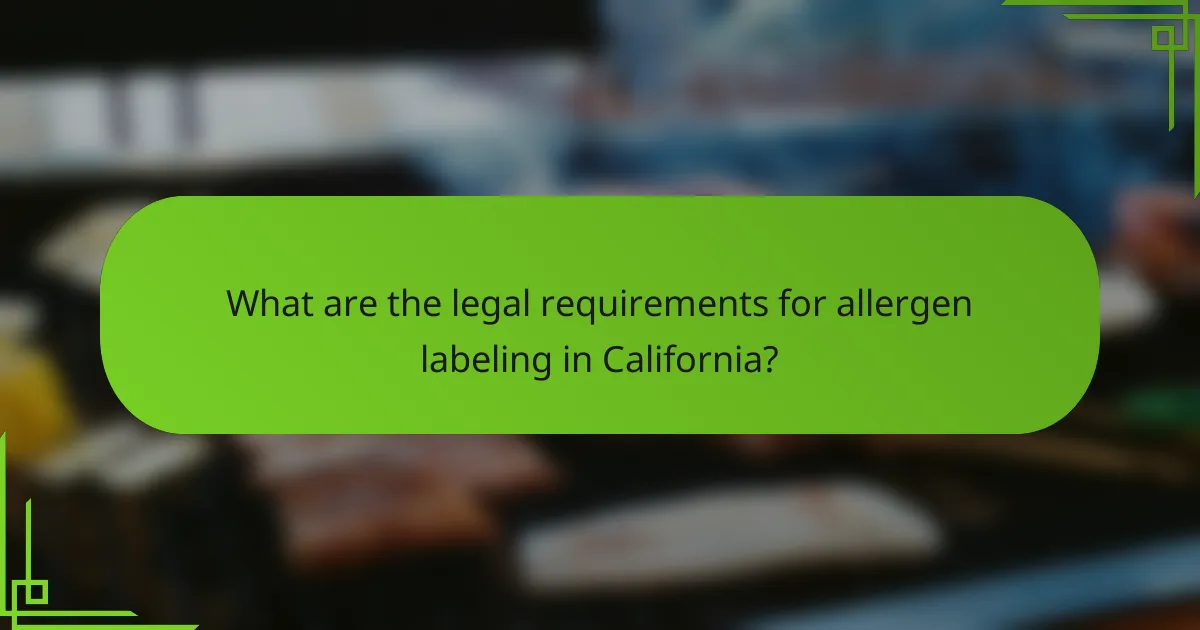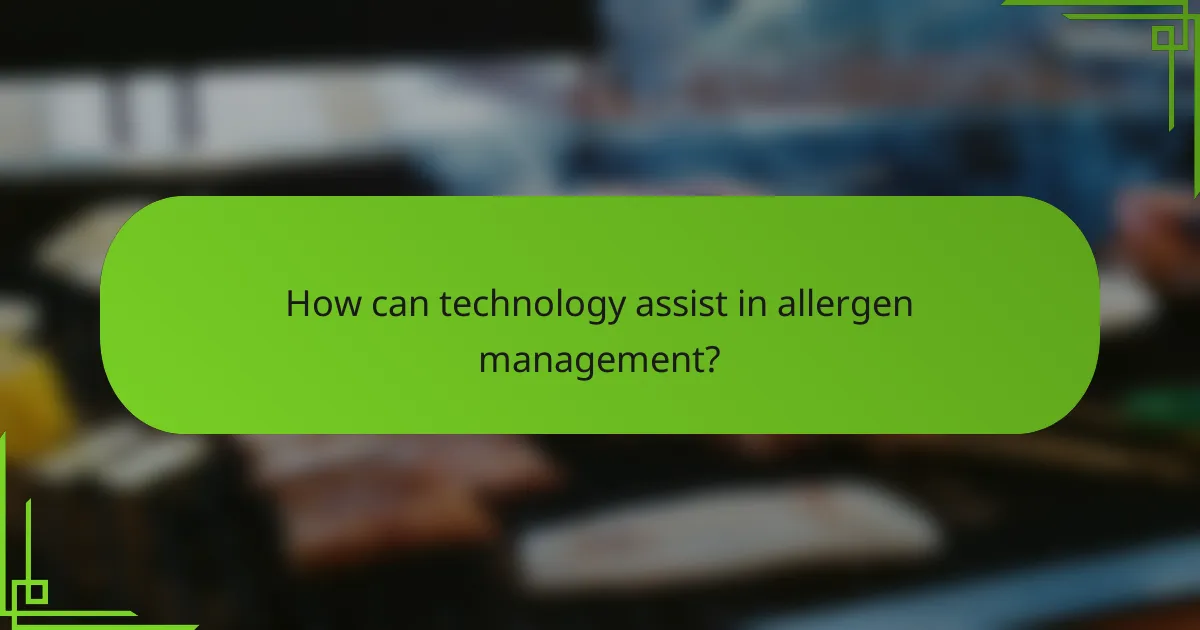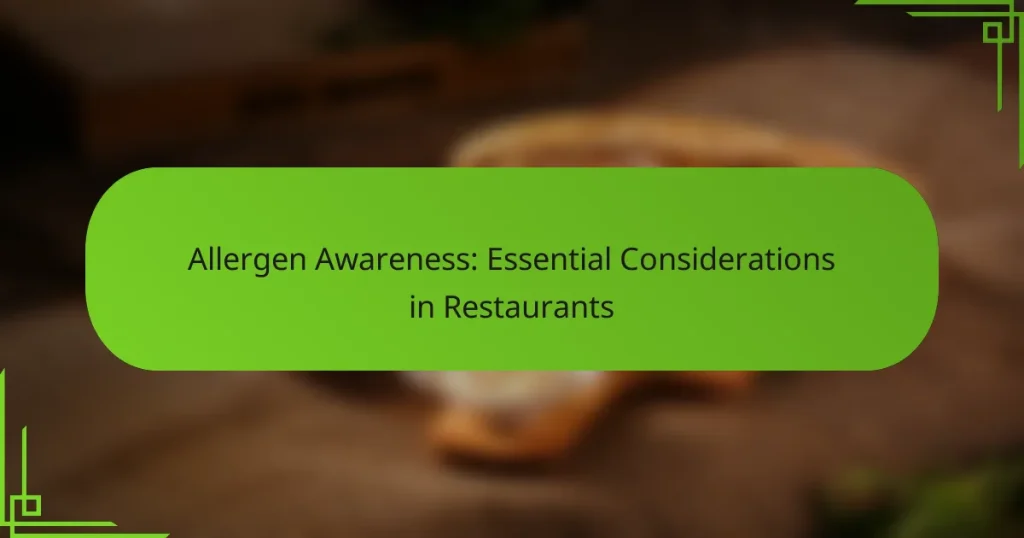Allergen awareness is a critical aspect of restaurant operations, as it directly impacts the safety and well-being of customers with food allergies. By implementing comprehensive training for staff, clear labeling of menu items, and regular allergen audits, restaurants can create a safer dining environment. Understanding common allergens and establishing effective communication protocols are essential steps in managing allergen risks and enhancing the overall dining experience.

How can restaurants improve allergen awareness in Los Angeles?
Restaurants in Los Angeles can enhance allergen awareness by implementing comprehensive training for staff, ensuring clear labeling of menu items, conducting regular allergen audits, and collaborating with local health departments. These strategies help protect customers with food allergies and create a safer dining environment.
Staff training programs
Effective staff training programs are crucial for improving allergen awareness in restaurants. Employees should be educated on common allergens, cross-contamination risks, and how to respond to customer inquiries regarding food safety. Regular refresher courses can help maintain knowledge and awareness.
Consider incorporating hands-on training sessions that simulate real-life scenarios, allowing staff to practice identifying allergens in dishes and managing customer requests. This practical approach can significantly enhance their confidence and competence in handling allergen-related issues.
Clear labeling of menu items
Clear labeling of menu items is essential for informing customers about potential allergens. Menus should indicate which dishes contain common allergens such as nuts, dairy, gluten, and shellfish. Using symbols or color-coding can make it easier for diners to identify safe options quickly.
Additionally, providing detailed ingredient lists upon request can further assist customers with allergies in making informed choices. This transparency not only builds trust but also encourages repeat business from health-conscious diners.
Regular allergen audits
Conducting regular allergen audits helps restaurants identify and mitigate risks associated with food allergens. These audits should assess food preparation areas, storage practices, and menu offerings to ensure compliance with allergen safety standards. Regular checks can help spot potential cross-contamination issues before they affect customers.
Establish a schedule for these audits, such as quarterly or biannually, and involve staff in the process to promote a culture of safety. Documenting findings and corrective actions taken can also provide a useful reference for future audits.
Collaboration with local health departments
Collaborating with local health departments can enhance allergen awareness initiatives in restaurants. Health authorities often provide resources, training, and guidance on best practices for allergen management. Engaging with these organizations can help restaurants stay updated on regulations and community health trends.
Participating in local health programs or workshops can also offer networking opportunities with other food service professionals, allowing for the exchange of ideas and strategies to improve allergen safety. This collaboration can ultimately lead to a more informed and health-conscious dining community.

What are the common allergens in restaurant food?
Common allergens in restaurant food include peanuts, tree nuts, dairy, and shellfish. These ingredients can trigger severe allergic reactions in sensitive individuals, making it crucial for restaurants to manage and communicate allergen information effectively.
Peanuts
Peanuts are one of the most prevalent allergens found in various dishes, especially in Asian cuisine and snacks. Even trace amounts can cause serious reactions, so restaurants must ensure that peanut-containing items are clearly labeled and separated from other foods.
When preparing meals, staff should avoid cross-contamination by using separate utensils and cooking surfaces. It’s advisable to inform customers about the presence of peanuts in sauces, dressings, or garnishes.
Tree nuts
Tree nuts, including almonds, walnuts, and cashews, are another common allergen that can be found in desserts, salads, and sauces. Similar to peanuts, tree nuts can provoke severe allergic responses, necessitating careful handling and clear communication.
Restaurants should provide detailed ingredient lists for dishes and train staff to recognize tree nut allergies. Offering nut-free alternatives can also enhance safety for allergic patrons.
Dairy
Dairy products, such as milk, cheese, and butter, are frequently used in many restaurant meals, making them a significant allergen. Lactose intolerance is also common, which can lead to discomfort for those affected.
To accommodate dairy allergies, restaurants should offer dairy-free options and clearly indicate which dishes contain dairy. Staff should be trained to suggest suitable alternatives, such as plant-based milk or vegan cheese.
Shellfish
Shellfish, including shrimp, crab, and clams, are known allergens that can cause severe reactions. They are often featured in seafood dishes, making it essential for restaurants to identify them on menus.
Preventing cross-contact with shellfish is critical, so kitchens should implement strict protocols for cleaning and preparing food. Clear labeling and staff training can help ensure that customers with shellfish allergies are adequately informed and protected.

How to create an allergen management plan?
Creating an allergen management plan involves identifying potential allergens in your menu, establishing clear communication protocols, and implementing a response strategy for allergic reactions. This structured approach helps ensure the safety of customers with food allergies and enhances overall dining experiences.
Identify allergens in all dishes
Begin by thoroughly reviewing all menu items to identify common allergens such as nuts, dairy, gluten, shellfish, and soy. Maintain a comprehensive list that includes ingredients and potential cross-contamination risks during preparation and service.
Consider using a standardized allergen chart that categorizes dishes by their allergen content. This can help staff quickly reference which items are safe for customers with specific allergies.
Establish communication protocols
Effective communication is crucial in managing allergens. Train staff to ask customers about their allergies when taking orders and ensure they understand how to relay this information to the kitchen. Use clear labeling on menus to indicate which dishes contain allergens.
Implement a system for documenting customer allergies, such as a dedicated section in the order system, to ensure all team members are aware of specific dietary restrictions. Regularly review and update this information as needed.
Implement a response strategy
Develop a clear response strategy for allergic reactions, including emergency procedures and staff training on how to handle such situations. Ensure that all employees know the location of first aid kits and how to contact emergency services.
Conduct regular drills to prepare staff for potential allergic reactions, reinforcing the importance of quick and effective responses. This proactive approach can significantly reduce risks and enhance customer trust in your establishment.

What are the legal requirements for allergen labeling in California?
In California, restaurants must comply with specific allergen labeling requirements to ensure consumer safety. This includes clearly identifying major allergens in food items and providing information on cross-contamination risks.
California Retail Food Code compliance
The California Retail Food Code mandates that food establishments must inform customers about the presence of major allergens, such as milk, eggs, peanuts, tree nuts, fish, shellfish, soy, and wheat. Restaurants must ensure that menus or labels clearly indicate these allergens, either through symbols or written descriptions.
Additionally, establishments should have procedures in place to prevent cross-contact between allergenic and non-allergenic foods. This may involve using separate utensils, cooking surfaces, and storage areas for allergenic ingredients.
Allergen training certifications
Staff at restaurants are required to undergo allergen training to recognize and manage food allergies effectively. This training helps employees understand the importance of allergen awareness and how to communicate potential risks to customers.
Certification programs, such as those offered by the National Restaurant Association, provide comprehensive training on allergen management. Regular refresher courses are recommended to keep staff updated on best practices and regulatory changes.
Penalties for non-compliance
Failure to comply with allergen labeling regulations in California can result in significant penalties for food establishments. Violations may lead to fines, license suspensions, or even closure of the business in severe cases.
To avoid penalties, restaurants should conduct regular audits of their allergen labeling practices and ensure all staff are trained and informed. Keeping detailed records of allergen training and customer inquiries can also help demonstrate compliance during health inspections.

How can technology assist in allergen management?
Technology plays a crucial role in allergen management by enabling restaurants to track, communicate, and manage allergen information effectively. Tools such as allergen management software, mobile apps, and digital menus help ensure that both staff and customers have access to accurate allergen data.
Allergen management software
Allergen management software allows restaurants to maintain detailed records of ingredients and allergens in their menu items. This software can automatically flag dishes that contain specific allergens, making it easier for staff to provide accurate information to customers. Regular updates and audits of ingredient lists are essential to keep this information current.
Mobile applications
Mobile applications can enhance allergen awareness by providing customers with instant access to allergen information. These apps often allow users to filter menu items based on their specific allergies, ensuring they can make safe dining choices. Restaurants can also use these platforms to communicate any changes in menu items or ingredients in real-time.
Digital menus and signage
Digital menus and signage can display allergen information clearly and prominently, helping to reduce the risk of allergic reactions. By using color coding or icons to indicate allergens, restaurants can make it easier for customers to identify safe options. Regularly updating digital content is crucial to reflect any changes in recipes or ingredient sourcing.


